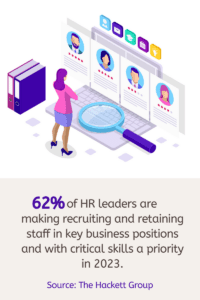Companies are actively competing with one another for the best talent, and for those that want to win, they must update their acquisition approaches.
By Zee Johnson
It’s no secret that the labor market remains tight, and companies are steadily testing their tactics to see which will appeal to needed talent. In fact, The Hackett Group reports that 62% of HR leaders are making recruiting and retaining staff in key business positions and with critical skills a priority in 2023. Because of this, many are now considering non-traditional ideas that offer the best chance at delivering the skilled talent they seek while also retaining their best employees.
Tammy Browning, President of KellyOCG, agrees that TA leaders are getting creative in order to secure top performers. She recommends these strategic approaches to get ahead in the current landscape.
- Evaluate all positions. Looking closely at new and existing roles can help companies determine the most ideal working structure
 for them (remote, hybrid, or on-site), which also creates space for agility. “Organizations need to adopt an approach to working that satisfies both business needs and the desires of their employees over the long-term,” Browning says. “Remote and hybrid roles expand the geographic regions where recruiters can find talent with the necessary skill sets giving companies access to a far more diverse pool of workers.” With that expanded reach, Browning says organizations will need to have an understanding of how to retain that talent. This can be aided by virtual recruiting hubs, for instance, which are online centers with team members who have extensive knowledge of the local market and are even fluent in several languages.
for them (remote, hybrid, or on-site), which also creates space for agility. “Organizations need to adopt an approach to working that satisfies both business needs and the desires of their employees over the long-term,” Browning says. “Remote and hybrid roles expand the geographic regions where recruiters can find talent with the necessary skill sets giving companies access to a far more diverse pool of workers.” With that expanded reach, Browning says organizations will need to have an understanding of how to retain that talent. This can be aided by virtual recruiting hubs, for instance, which are online centers with team members who have extensive knowledge of the local market and are even fluent in several languages. - Internal mobility programs. With nearly 40% of workers leaving organizations that don’t offer career progression and a third of global employees expected to quit their jobs this year, Browning says internal mobility programs connect workers to new growth opportunities within the company. This approach fills critical roles while empowering employees to stay at the organization. But TA teams should take heed: While this is a great recruiting strategy, it requires time and attention to streamline the process. Organizations need to ensure employees are aware of and have access to opportunities. A partnership with an RPO like KellyOCG can help support internal mobility efforts and allow organizations to leverage internal recruiting to fill open roles while retaining their current workforce.
- Reevaluate employer value proposition (EVP). Leaders should ask themselves: Does our EVP offer compelling reasons for why candidates would want to work here? Does it encourage current employees to stay? “If you answered ‘no’ to one or both questions, your EVP needs some attention,” Browning says. With so many market changes in the last few years, now is the right time for an EVP redesign. Where to start? “A strong EVP highlights your key selling points, identifies the characteristics that employees should possess, aligns with your corporate values, and speaks to the needs of your current employees,” she says.
There are no indicators that the pressure of the labor market will ease any time soon. The constant stress to find the best talent, coupled with on-going employee turnover is putting a lot of strain on internal TA teams. What’s the solution? “Leading organizations are partnering with RPO providers to balance the workload of their in-house team and expand their recruiting capabilities to connect with more diverse talent communities.” She says a strong RPO provider like KellyOCG can give companies the agility they seek while hiring.
And it goes without saying that talent acquisition must be done by a team that understands the company and its brand. When done right, organizations gain new skills, tools, recruiting techniques, and key talent.














